THE ROLE OF THE
THE ROLE OF THE
THE ROLE OF THE
Create successful ePaper yourself
Turn your PDF publications into a flip-book with our unique Google optimized e-Paper software.
Design Concerns and Imperatives 53<br />
table 4.2<br />
Finite element analysis versus testing<br />
Finite element analysis testing<br />
Building FE model and running analysis are<br />
cheaper and faster<br />
4.6 Fea PerFormance PredIctIons<br />
and some Key deFInItIons<br />
Building and testing physical parts is costly and<br />
takes a long time<br />
No parts are physically involved Tests are usually destructive<br />
Multiple analysis must be done to account for part<br />
and build variations<br />
Evaluation of different design alternatives is very<br />
easy<br />
Multiple physical tests must be done to account<br />
for part and build variations<br />
Evaluation of different design alternatives is a<br />
long and costly process<br />
Design optimization is easier Design optimization cannot be done easily<br />
Accuracy: The ability of the FEA to predict actual behavior, mainly affected by the<br />
quality of model inputs, mesh refinement, and others.<br />
Convergence: Technique for obtaining greater accuracy from an FEA by iteratively<br />
refining the mesh in areas of greatest concern until outputs<br />
stabilize.<br />
Isotropic: In FEA, this concept is assumed. It is a material that has the same strength<br />
in all directions (as opposed to anisotropic materials).<br />
Modulus of elasticity (E): Also known as Young’s modulus, a numerical constant<br />
unique to each material that describes the elastic properties of the material<br />
when loaded in the compression or in tension.<br />
Poisson ratio: The ratio of transverse contraction strain to longitudinal extension<br />
strain in a stretched bar. The maximum possible value is 0.5 (around 0.5 for<br />
rubber, 0.33 for aluminum, 0.28 for common steels, and 0.1–0.4 for polymer<br />
foams).<br />
Singularity: Geometrically, the term used to describe a discontinuity such as<br />
a fillet or part wall that causes an FEA result to diverge as the mesh is<br />
refined.<br />
Stiffness: A measure of the force required to deform a material in the elastic range.<br />
To increase stiffness, a chemist or engineer will use a material with a higher<br />
Young’s modulus.<br />
Strain: Ratio of the change in length of a part to its original length (∆l/L).<br />
Strength: A measure of a material’s ability to resist loads without deforming permanently.<br />
To increase strength, a material with a higher yield stress must<br />
be used.<br />
Stress: Force per unit area in newtons per square meter (pascal) or pounds per square<br />
inch. If the material is stretched, then it is in tension. Compressive stress is<br />
often examined as well.







